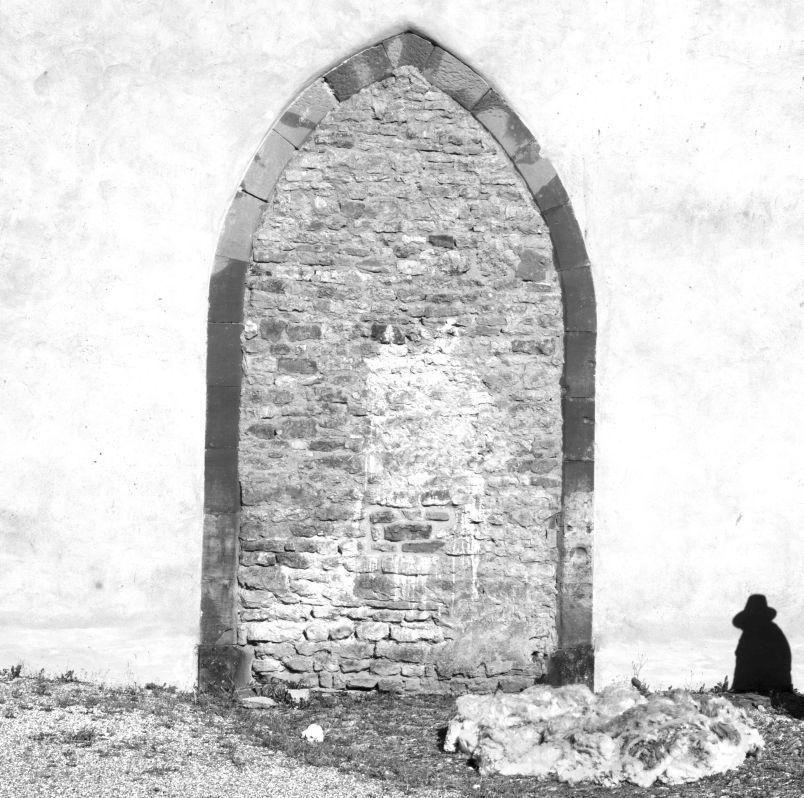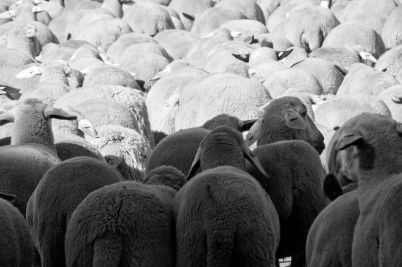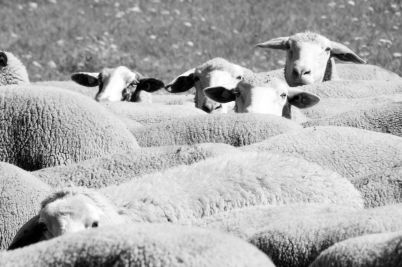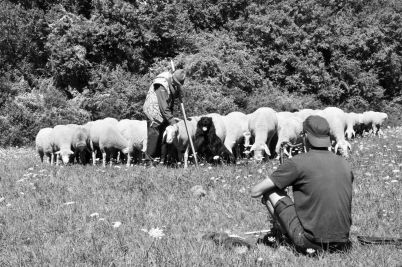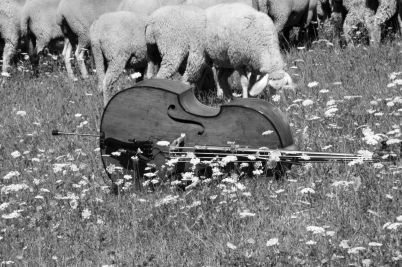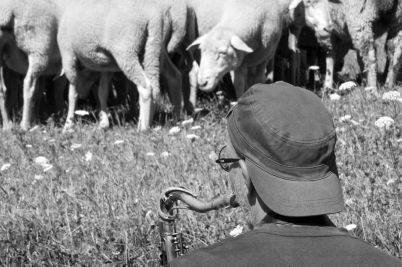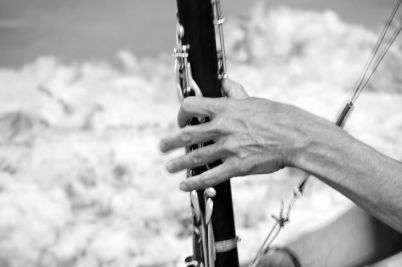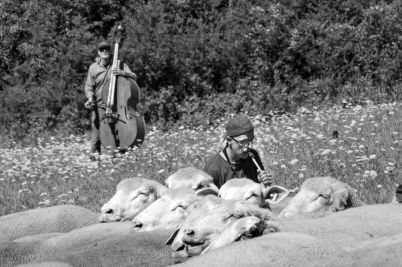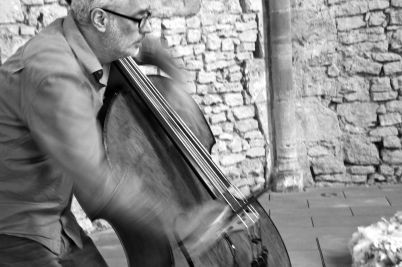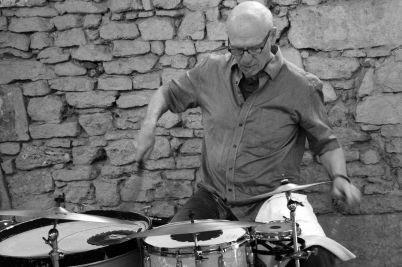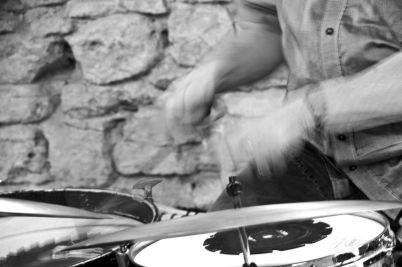Concert for sheep and the diversity of species
When jazz musicians leave human language behind in the remains of an old priory church of the Premonstratensians and near a flock of sheep in the surrounding Bliesgau landscape in order to improvisationally create sounds, new experimental spaces for exchange between humans, habitat and all non-human living beings can emerge. This sound image involuntarily quotes the myth of the "primeval sound of the earth" and likewise the elementary basic idea of the UNESCO Biosphere Reserve Bliesgau: to bring a habitat with all its creatures into a synergetic exchange - preserving the whole.
The concert for sheep of the trio formation Autochthon (Hartmut Oßwald - saxophones, bass clarinet, Stefan Scheib - double bass, Wolfgang Schliemann - percussion) ties - in a time when live concerts in front of people are suspended due to a pandemic - to the relationship of man to his habitat - the biosphere earth: "Man and the Biosphere" sums it up UNESCO.
How do sheep as representatives of the non-human living beings and the "world-soul", which can just be sensed in the all-connecting nature, react to unfamiliar sound worlds, if these are consciously directed to them? Can resonances between the [life]
The artistic experiment wants to make it sensually tangible and audible how resonances on the unique planet earth are triggered by the effective power of artistic processes. Music as a variant of artistic forms of expression translates, as is well known, much that humans can hardly convey by means of language. The nature-given capacities for aesthetic feeling, thinking and creating are deeply anchored in the human organism, and these potentials can be trained and brought to life in people. In search of fields of hope for an ecologically and ethically justifiable form of human existence, the unusual idea experiments with the question of the extent to which worlds of sound can trigger a transformative energy between living beings and habitat.
Prologue
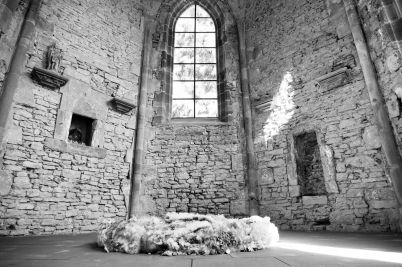
ShepherdsCircle (circle of virgin wool at the cultural site Wintringer Chapel), Rudolf Schwarz, KunstSchäfer

The shepherd who tends a flock, with his dogs, reduces the flock from a wide to a narrow herd and in the middle of the day rhythm to a "herd circle". The sheep lie down, relax and begin to ruminate. It is the phase that every shepherd strives for every day and also uses for his own relaxation and rest.
Cultural site Wintringer Chapel
As a refuge for a prologue to the "Concert for Sheep" the trio has chosen the cultural site Wintringer Chapel on the Wintringer Farm. The site dates back to Roman times and to this day, like a gateway into the light, opens up a view of a vast landscape that was once the bottom of the sea and is now recognized as the Bliesgau UNESCO Biosphere Reserve.
It was probably no coincidence that a priory of the Premonstratensian Order was established at this special place in the Middle Ages, also from a geomantic point of view. The historical sources document fruit and wine growing, a special garden and sheep breeding among the monks. The relationship between the shepherd and the flock of sheep and their high symbolic power can be thematized here in a poetic way.
What echo from the depths of time can be activated in the remains of the medieval priory church, preserved to this day, by sounds from the present day? In the late Middle Ages, monks sometimes preached here about the relationships between God, human beings and the wonders of creation. The Bible was rich in references: "... and Jesus said, I am the "Good Shepherd," I know mine and mine know me (John's Gospel 10:3)." In those moments when the monks gave the blessing to their human "flocks" with Psalm (23) "The Lord is my Shepherd," the bleating of the associated flock of sheep could sometimes be heard in the surrounding pastures.
The peacefully grazing flock of sheep with the good shepherd is still considered a symbol of the creature entrusted to man. In the passing landscape, the shepherd assumes responsibility for the welfare of his animals as well as for the diversity of species in nature. He sees himself as a propagator of life and diversity and a counter-image to the restless consumption of resources necessary for survival.
On the way in the Bliesgau
In the Bliesgau region, the fruit thrives predominantly on limestone soils left behind by the sea from prehistoric times. At harvest time in midsummer, the trio is on the road with a flock of sheep from the Bliesgau-Bio-Schäferei Ernst in the landscape around Seelbach to sound out with their instruments whether the communication level of music belongs only to the nature of man or whether animals do not also react to and with sound worlds. On the way, the musicians let their sounds flow together with the sheep and all other creatures of the landscape.
The Concerto for Sheep musically alludes to parallels with the highly diverse levels of communication among living beings. Animals, we know, communicate with humans through body language, facial expressions and gestures, eye contact, voice and mood, and body odor. In the production of sounds and in hearing, there are obviously interfaces that allow communication in the broadest sense - at least with animals.
This realization opens the question about the spectrum of the perception or communication possibilities with our sensitive fellow creatures in the plant world. In any case, collectively all living beings - human and non-human - form a habitat. All together form the big whole by their contribution to a miracle work which is not able to survive without interaction and a cooperation in friendly understanding and relationship.
Interplay
However, the signals and messengers that keep this web of relationships as a large whole - biosphere Earth - in an ecological balance or tip it over, are sent almost exclusively from humanity in the Anthropocene era. The threatening thing is that no balancing levels, symbioses and relationships are found in the tangle of sounds of earthly living beings. Humans seem to ignore that non-human living beings such as animals and plants are sensitive to balance. Yet these living things have been shown to have memory and are capable of learning. If one of their species goes extinct, the diversity of the entire system is threatened. The wounds are painful and hardly healable.
The call for compensation echoes audibly over the earth circle and postulates in the figurative sense possibly also the actual message of uncontrollable epidemics: Here is finally an end with greed and an absolute (new) beginning.
However, a new beginning seems hardly conceivable without the realization that both animals and plants have a consciousness and require a high esteem corresponding to that of humans. In order to ensure an ethically and ecologically sustainable coexistence, mankind will probably not be able to avoid a "reset", because man, who sees himself as the crown of creation and consumes senselessly, is a discontinued model.
Against this background, the Concert for Sheep deliberately enters an experimental space. Primarily to send sounds/
Animated nature
The sound worlds and snapshots of the musicians at the cultural site Wintringer Chapel (prologue) and in the midst of a grazing flock of sheep in the summer landscape of the Bliesgau create a sound image that is directed at a receptive, non-human environment in order to highlight the interconnectedness of organisms in an artistic way.
Empathic humanity [Conditio humana] as an essential condition for the art of living is thus metaphorically set in sound: Being in relationship [klingen].
It is about the relationship between humans and nature or habitat as a structure of interaction that cannot function sustainably without an intensive experience of nature and cultural education: Allconnectedness. A sense of empathic relationship and resonance with the wonders and treasures that this planet Earth - the biosphere - provides. This kind of togetherness can be experienced intensely, especially when the most diverse atmospheres are brought together and condensed through artistic influence.
The film
"Concert for sheep [... and the diversity of species]" was recorded and edited as a film sequence by the trio formation Autochthon.

The film project "Concert for Sheep [... and the Diversity of Species]" sees itself as an experiment in spreading sustainable ways of life in the Bliesgau Biosphere Reserve and as a contribution to cultural education for sustainable development.
Excursus
Bliesgau Biosphere Reserve
The term biosphere (Greek, βίος bíos 'life' and σφαίρα sphaira 'sphere') refers to the space with life of a celestial body (source: wikipedia.org). This "sphere of life" Earth is a unique space with a wide variety of habitats, cultures and peoples of humanity as well as non-human species, which are in a multiple synergistic relationship. BIOSPHERE (habitats) RESERVATE (preserve) means to protect and preserve the abundance and life-giving qualities on our Earth - Creation - in the present and for future generations, as well as to ensure the ethical foundation necessary for this within the cultures and peoples of this planet through education for cultural and sustainable development.
In 1970, UNESCO ("United Nations Educational, Scientific and Cultural Organization") established the biosphere reserves. They are an essential part of the program "Man and the Biosphere" with the aim of developing and testing a compatible and lasting coexistence of man and nature through exemplary measures. By June 2019, 701 biosphere reserves had been established on our planet in 124 countries.
www.biosphaere-bliesgau.euEcocide - State of emergency of nature
The UN's World Biodiversity Council's (IPBES) 2019 Species at Risk report paints a dramatic picture: around one million species could disappear within the next few decades if the state of our ecosystems continues to deteriorate. The integrity of 75 percent of land areas and 66 percent of marine areas is severely compromised by human impact. As a result, the existence of a quarter of recorded animal and plant species worldwide is threatened. Ultimately, this trend can only be halted by a change of perspective within society. Furthermore, a transformation of the idea of nature conservation to a level that is supported from the heart by people on a broad scale is required. The preservation of biological diversity always serves the preservation of human livelihoods - both globally and locally.
The protection of nature and its diverse species succeeds mostly when people in their own homeland understand what is at stake for you and the generations that follow us. For their survival and well-being depends directly on the preservation of their homeland and natural resources.
The new 10-year strategy of the UN Convention on Biological Diversity, negotiated at the 15th Conference of the Parties (CoP15) in China in October 2020, sets a major course to move all countries toward living "in harmony with nature" by 2030. WWF is calling for leaders to commit to concrete action to effectively do more to protect biodiversity, including by creating better and more effective laws, promoting sustainable food production, reducing subsidies that are harmful to nature, and increasing funding for protected areas.
Idea and musical realization: Trioformation Autochthon (Hartmut Oßwald, Stefan Scheib, Wolfgang Schliemann)
Film editing: Katharina Bihler, Stefan Scheib and Hartmut Oßwald
Text, photographs: Peter Michael Lupp
The art shepherd Rudolf Schwarz inspired the project with his expertise as a shepherd and shepherd and was able to win the Bliesgau-Bio-Schäferei Ernst in Assweiler/Seelbach with their flock of sheep as participants.
Brochure "Concert for sheep and the diversity of species"
Print version: pm.lupp@web.de

